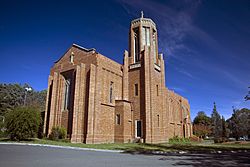St Paul's Church, Manuka facts for kids
Quick facts for kids St Paul's, Manuka |
|
|---|---|

St Paul's Church (2010)
|
|
| 35°19′13″S 149°08′09″E / 35.32028°S 149.13583°E | |
| Location | Griffith, ACT |
| Country | Australia |
| Denomination | Anglican |
| History | |
| Status | Parish church |
| Dedication | Paul the Apostle |
| Consecrated | 1939 |
| Architecture | |
| Heritage designation | ACT: Listed #157 National: Historic #17894 |
| Designated | ACT: 2011, National: 1992 |
| Groundbreaking | 1938 |
| Administration | |
| Parish | St Paul's |
| Diocese | Canberra and Goulburn |
St Paul's Church is a special Anglican church located in Griffith, a suburb of Canberra, Australia. It was built in 1939 and is part of the Anglican Diocese of Canberra and Goulburn.
This church is recognized for its unique design. It blends older Gothic styles with modern Art Deco touches. St Paul's was the first place in Australia to have a special type of organ. It also has the only set of bells in the Australian Capital Territory that can be rung freely.
It was the first Anglican church built after Canberra became Australia's capital city. The church is easy to find, located across from Manuka Oval and the shops in Manuka.
Contents
Church History: How St Paul's Began
The story of St Paul's Church started in 1914. Back then, it was part of St John the Baptist Church in Reid. A simple hall made of corrugated iron was put up in Eastlake (now Kingston). This hall was for the workers living in nearby camps.
In the 1920s, the hall was very busy. People gathered there every Sunday for services and Sunday school. By the 1930s, the church community was active. They had a choir and even football and cricket teams.
In 1933, people started saving money to build a permanent church. However, this was during the Great Depression, so progress was slow. A design by architects Burcham Clamp and Son was chosen in 1938. A parishioner named W. J. Perry was chosen to build it.
Building the Church
The first stone for the new church was laid on December 11, 1938. This important event was done by the Governor-General, Baron Gowrie. The church was officially opened on August 6, 1939. This was just five days after the 25th anniversary of the first Anglican service held in the old St Paul's Hall.
St Paul's was the first Anglican church built in the area since the 1840s. At first, it was still part of St John's parish. But on March 26, 1950, St Paul's became its own official parish. Neville Chynoweth, who later became a Bishop, was the rector (head priest) from 1971 to 1974. In 1988, an organ loft was added for Queen Elizabeth II's visit during Australia's Bicentenary celebrations.
Church Design and Features
St Paul's Church is built with red bricks. Its style mixes Art Deco and Gothic Revival designs. When it was first built, it only had the main part, called the nave. But it has been made bigger twice since then.
In 1956, a new sanctuary and a unique bell tower were added. Then, in 2001, two more sections were added to the nave. This made St Paul's the largest Anglican church in Canberra. Because of its size and location, it often hosts big church events for the whole area.
The Bells of St Paul's
The church tower holds the only set of change ringing bells in the Australian Capital Territory. These bells are used for a special type of bell ringing. St Paul's is the only church from the territory that is part of the Australian and New Zealand Association of Bellringers.
The eight bells came from different places. Some were specially made in England. They were all put into the tower in 2003.
The Church Organ
The first organ was installed in 1970. It was the first three-manual organ in Canberra. It was built mostly from older parts and had some missing pipes. After being damaged by rain, the organ was moved and greatly fixed up in 1990.
Today, the church has Australia's first "combination" or "hybrid" organ. This means it has both traditional pipe organ parts and modern digital electronic sounds. It has 24 pipe stops and 34 electronic stops, making a total of 57 different sounds. In 2009, a new four-manual console (the part with the keys and buttons) was added. In 2012, more improvements were made, including new sounds and pipes for the choir section.

